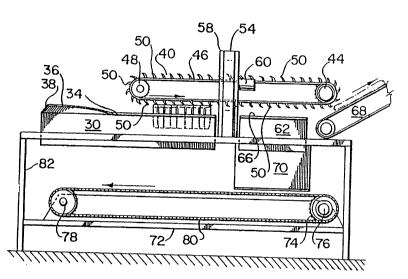Une partie des informations de ce site Web a été fournie par des sources externes. Le gouvernement du Canada n'assume aucune responsabilité concernant la précision, l'actualité ou la fiabilité des informations fournies par les sources externes. Les utilisateurs qui désirent employer cette information devraient consulter directement la source des informations. Le contenu fourni par les sources externes n'est pas assujetti aux exigences sur les langues officielles, la protection des renseignements personnels et l'accessibilité.
L'apparition de différences dans le texte et l'image des Revendications et de l'Abrégé dépend du moment auquel le document est publié. Les textes des Revendications et de l'Abrégé sont affichés :
| (12) Brevet: | (11) CA 2010034 |
|---|---|
| (54) Titre français: | APPAREIL ET METHODE DE COUPE DES VIANDES |
| (54) Titre anglais: | APPARATUS AND METHOD FOR CUTTING MEAT |
| Statut: | Périmé |
| (52) Classification canadienne des brevets (CCB): |
|
|---|---|
| (51) Classification internationale des brevets (CIB): |
|
| (72) Inventeurs : |
|
| (73) Titulaires : |
|
| (71) Demandeurs : | |
| (74) Agent: | MILTONS IP/P.I. |
| (74) Co-agent: | |
| (45) Délivré: | 1993-01-05 |
| (22) Date de dépôt: | 1990-02-14 |
| (41) Mise à la disponibilité du public: | 1991-08-14 |
| Requête d'examen: | 1990-02-14 |
| Licence disponible: | S.O. |
| (25) Langue des documents déposés: | Anglais |
| Traité de coopération en matière de brevets (PCT): | Non |
|---|
| (30) Données de priorité de la demande: | S.O. |
|---|
Abstract
The present invention relates to an apparatus and method of
cutting meat. The apparatus and method is particularly
directed to separating a backbone portion from a rib portion
of a piece of meat. The apparatus is comprised of a vertical
orientation unit for vertically orienting the piece of meat.
The orientation unit includes a longitudinal receiving channel
having a generally horizontal top surface, the surface having
a slot. The width of the slot accommodates the rib portion
but not the backbone portion so that the backbone portion is
held above the orientation unit. A moving unit is provided
and is adapted to contact the backbone portion for moving the
piece of meat horizontally in the direction of the
longitudinal axis of the channel. A cutting unit is provided
which includes a saw blade, a portion of which is oriented
horizontally, wherein the cutting unit horizontally cuts the
rib portion from the backbone portion.
Note : Les revendications sont présentées dans la langue officielle dans laquelle elles ont été soumises.
Note : Les descriptions sont présentées dans la langue officielle dans laquelle elles ont été soumises.

Pour une meilleure compréhension de l'état de la demande ou brevet qui figure sur cette page, la rubrique Mise en garde , et les descriptions de Brevet , États administratifs , Taxes périodiques et Historique des paiements devraient être consultées.
| Titre | Date |
|---|---|
| Date de délivrance prévu | 1993-01-05 |
| (22) Dépôt | 1990-02-14 |
| Requête d'examen | 1990-02-14 |
| (41) Mise à la disponibilité du public | 1991-08-14 |
| (45) Délivré | 1993-01-05 |
| Expiré | 2010-02-14 |
Il n'y a pas d'historique d'abandonnement
Les titulaires actuels et antérieures au dossier sont affichés en ordre alphabétique.
| Titulaires actuels au dossier |
|---|
| OLYMEL S.E.C./OLYMEL L.P. |
| Titulaires antérieures au dossier |
|---|
| COOPERATIVE FEDEREE DE QUEBEC |
| OLYMEL, SOCIETE EN COMMANDITE |
| PERREAULT, MARTIN |